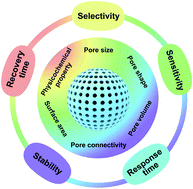New insights into the structure–performance relationships of mesoporous materials in analytical science
Abstract
Mesoporous materials are ideal carriers for guest molecules and they have been widely used in analytical science. The unique mesoporous structure provides special properties including large specific surface area, tunable pore size, and excellent pore connectivity. The structural properties of mesoporous materials have been largely made use of to improve the performance of analytical methods. For instance, the large specific surface area of mesoporous materials can provide abundant active sites and increase the probability of contact between analytes and active sites to produce stronger signals, thus leading to the improvement of detection sensitivity. The connections between analytical performances and the structural properties of mesoporous materials have not been discussed previously. Understanding the “structure–performance relationship” is highly important for the development of analytical methods with excellent performance based on mesoporous materials. In this review, we discuss the structural properties of mesoporous materials that can be optimized to improve the analytical performance. The discussion is divided into five sections according to the analytical performances: (i) selectivity-related structural properties, (ii) sensitivity-related structural properties, (iii) response time-related structural properties, (iv) stability-related structural properties, and (v) recovery time-related structural properties.



 Please wait while we load your content...
Please wait while we load your content...